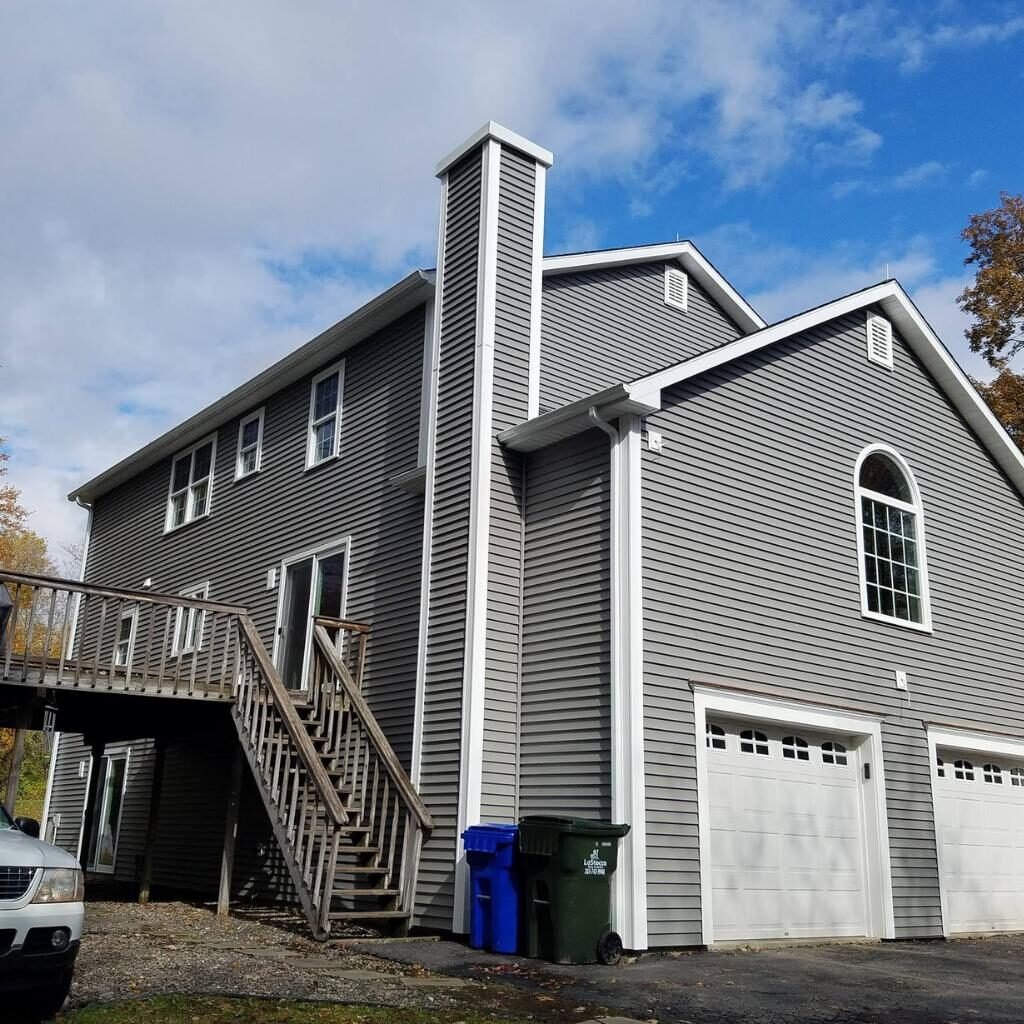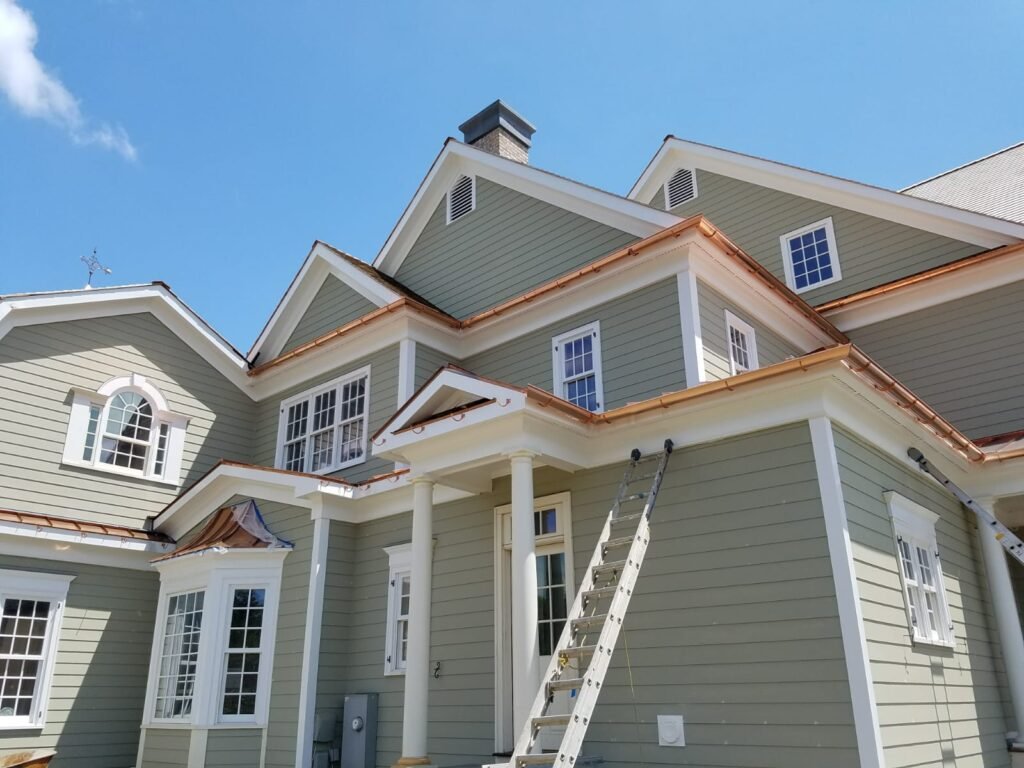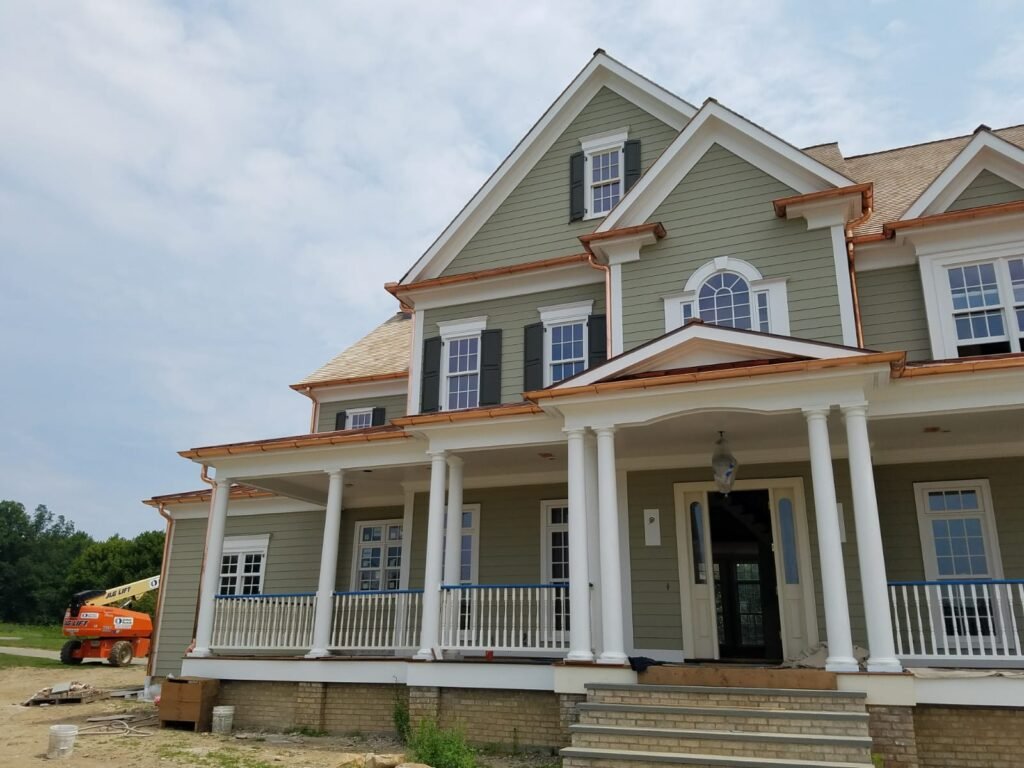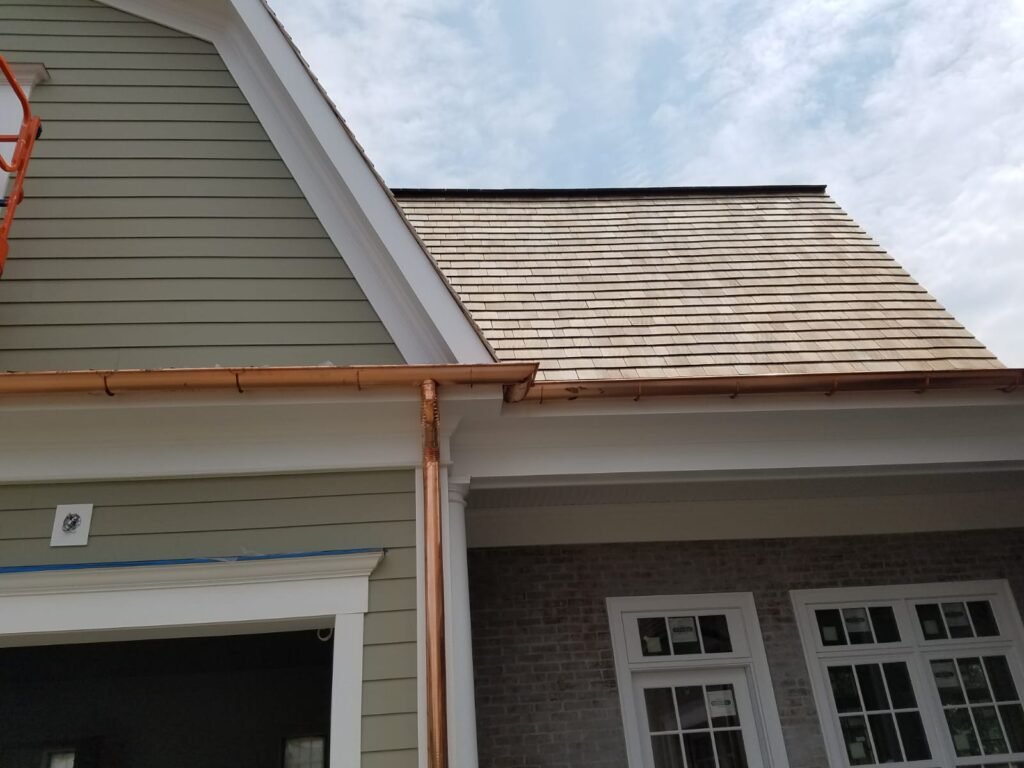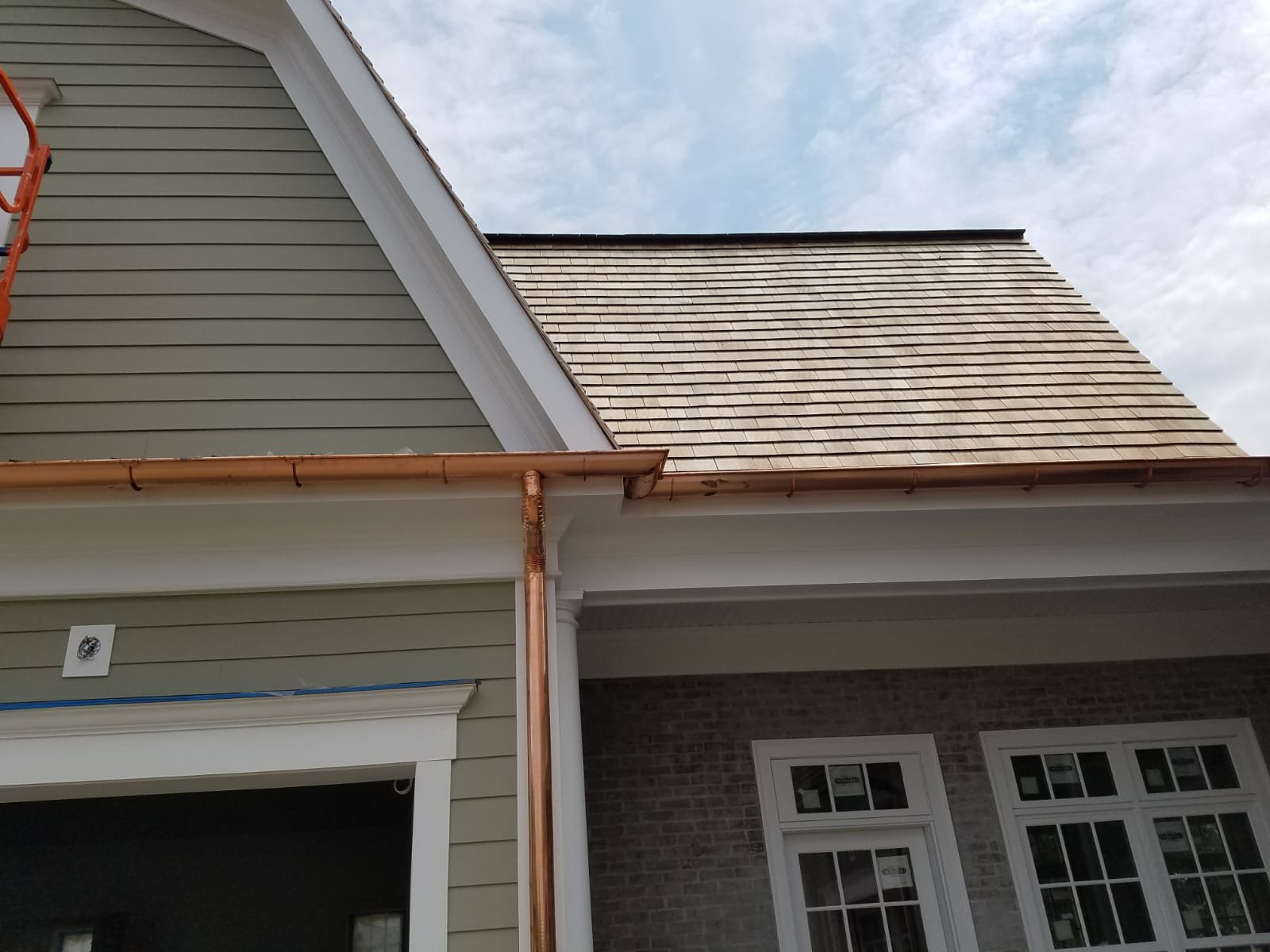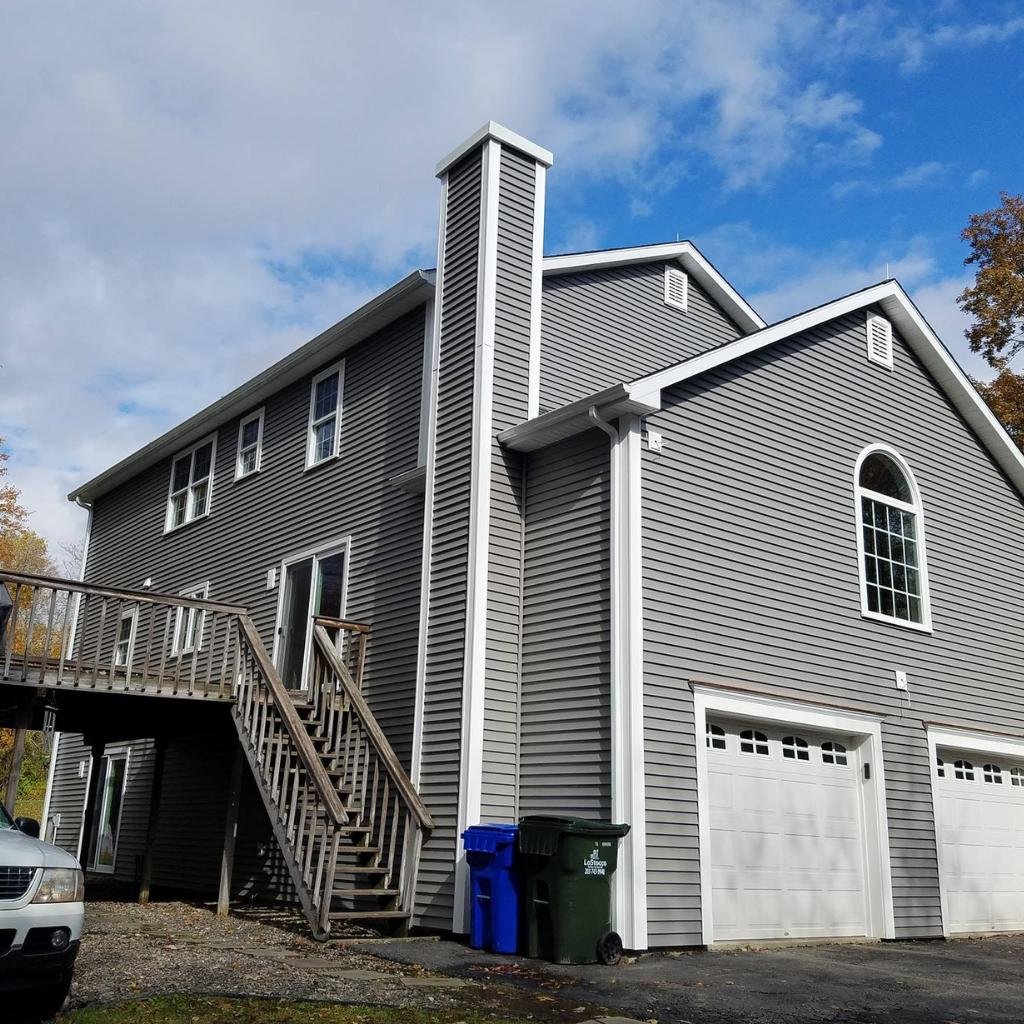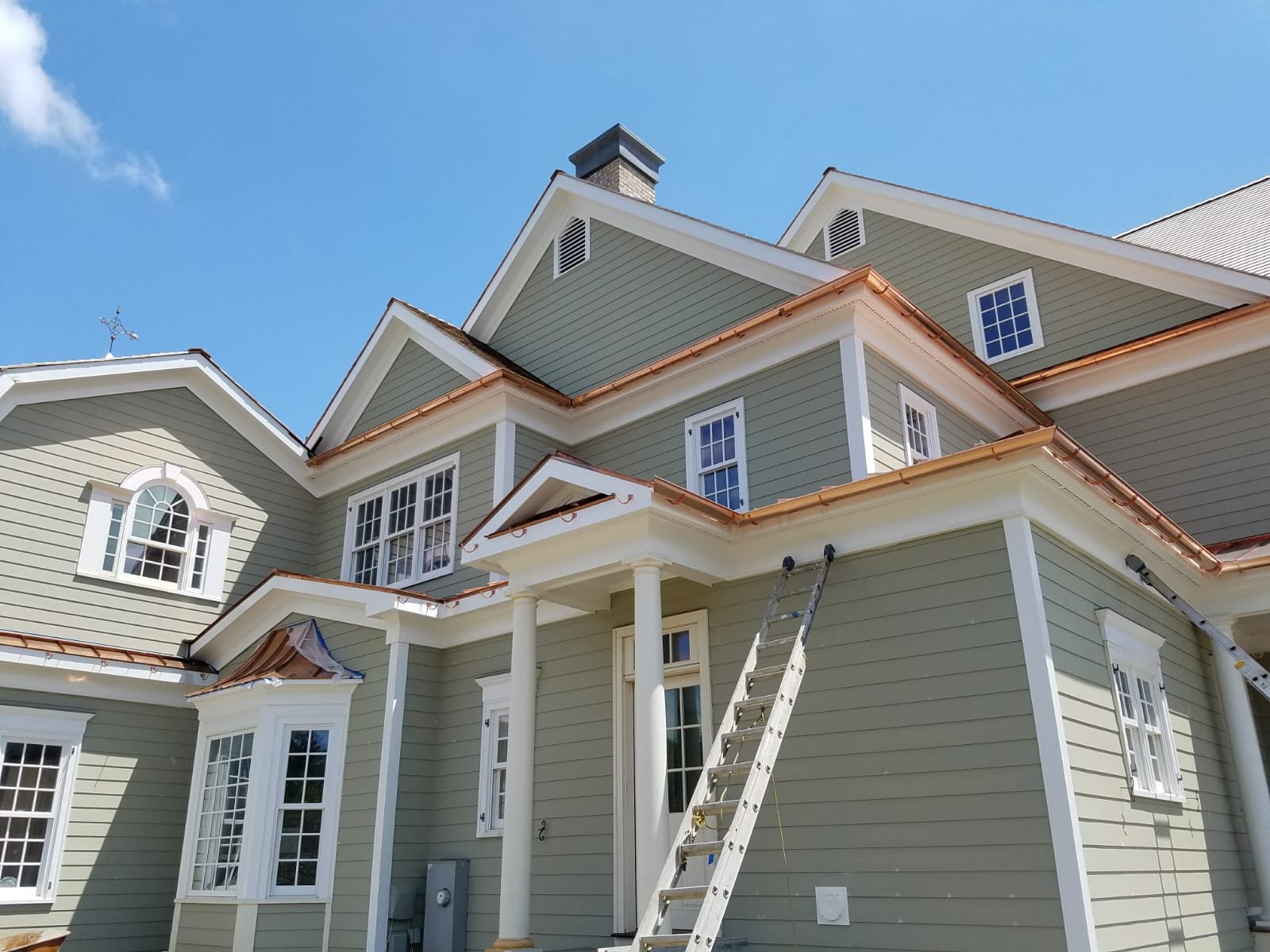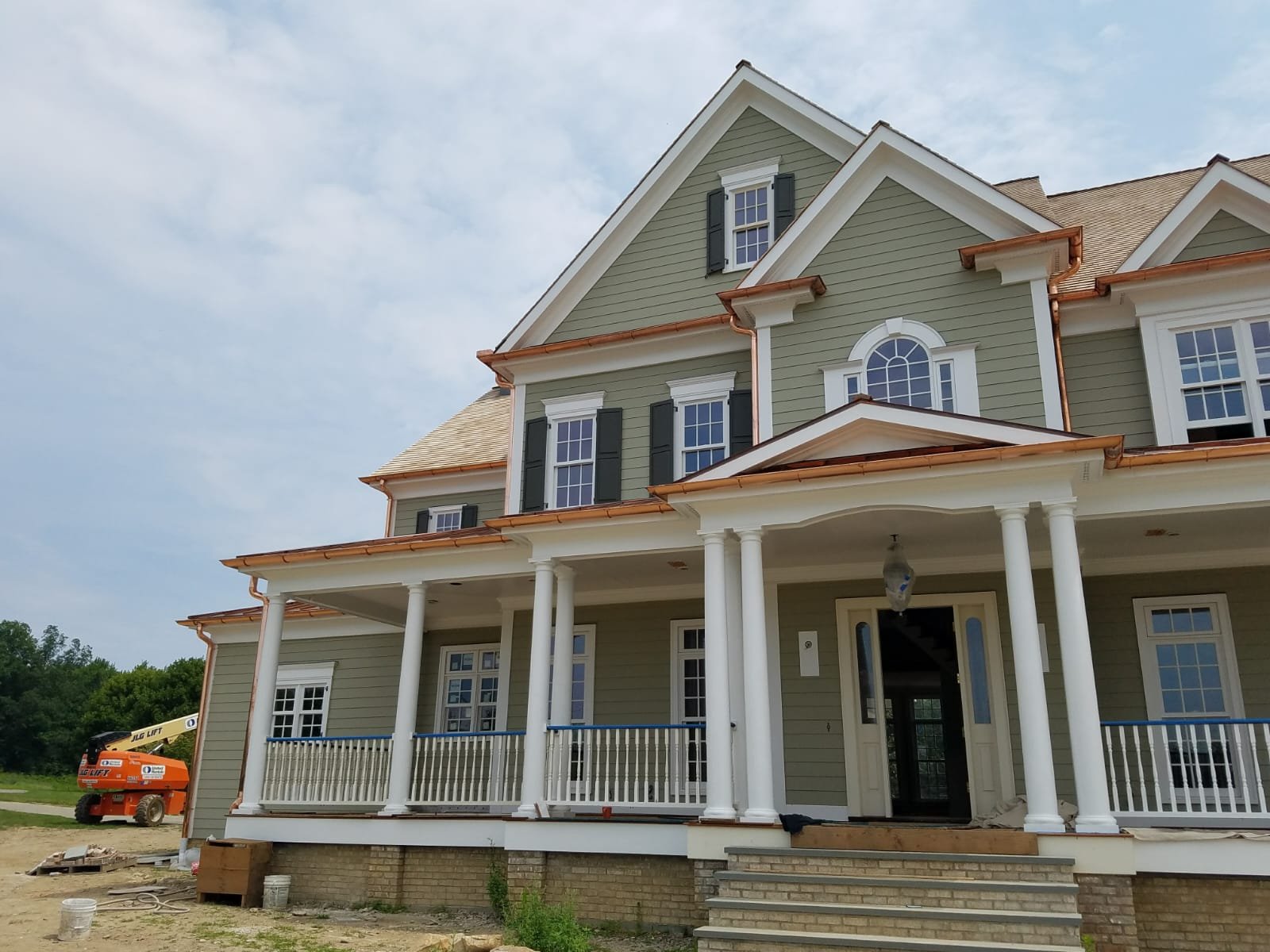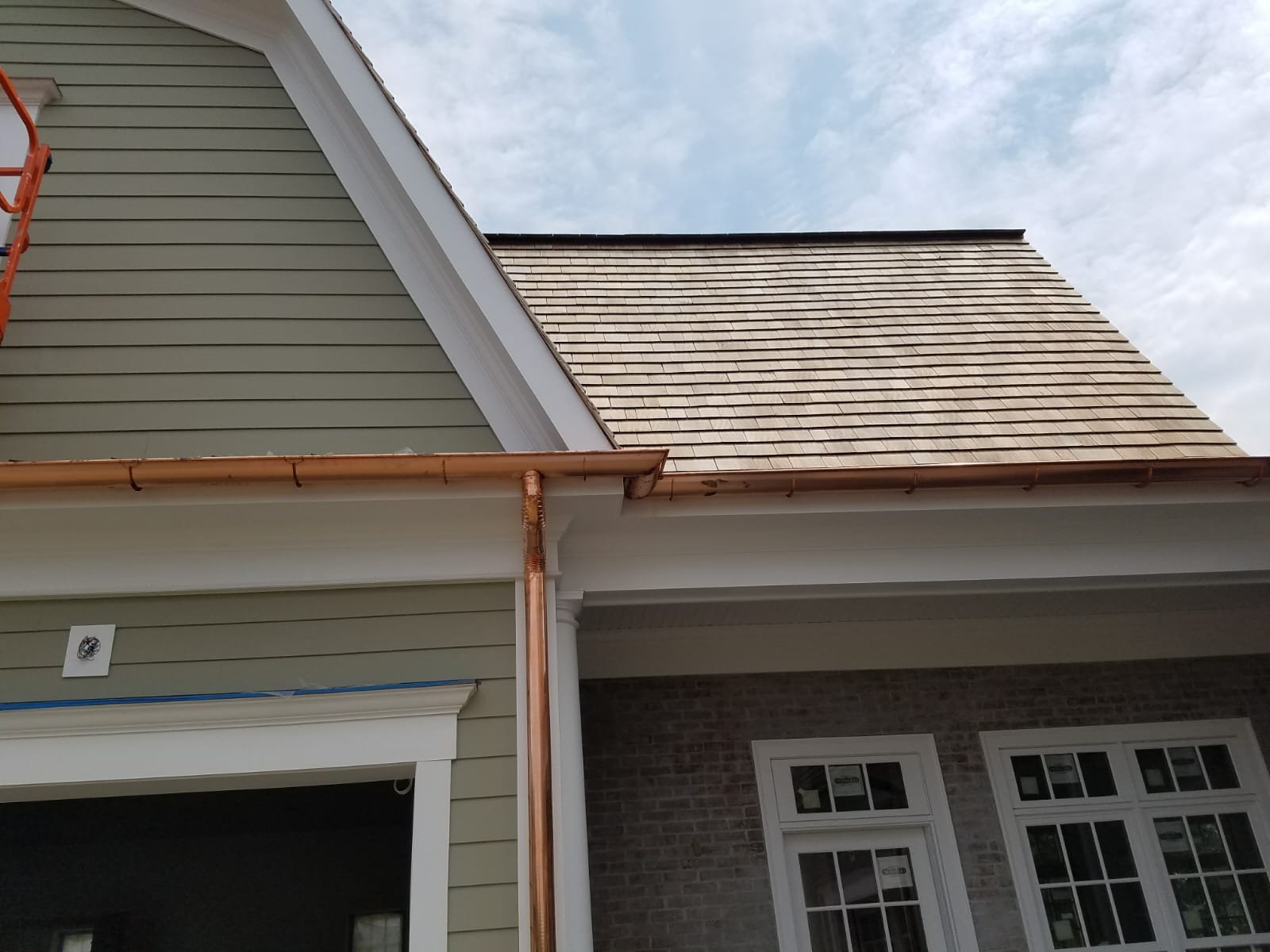Connecticut’s Downspout and Drainage Experts
Gutters collect water from your roof, but downspouts and extensions determine where that water goes. Without proper downspout placement and adequate extensions, thousands of gallons of water deposit directly against your foundation, creating the conditions for basement flooding, foundation damage, soil erosion, and structural problems that cost thousands to repair.
At American Quality Roofing and Siding, we’ve spent over 25 years designing and installing downspout systems throughout Connecticut. Our drainage specialists understand that effective water management requires strategic downspout placement, proper sizing, and extensions that carry water far enough from foundations to prevent damage. Connecticut’s heavy rainfall, spring snowmelt, and severe storms demand drainage solutions specifically designed for our climate’s water volumes.
Many Connecticut homeowners struggle with basement moisture, foundation cracks, or erosion problems without realizing inadequate downspouts cause these issues. Others have downspouts depositing water directly at foundation walls or extensions that have shifted, disconnected, or simply don’t extend far enough. Whether you need additional downspouts, proper extensions, underground drainage solutions, or complete system redesign, we provide water management that protects your most significant investment.
Connecticut’s soil conditions, varying terrain, and climate patterns require downspout solutions tailored to local conditions. Clay soils common in many areas drain poorly, demanding careful attention to water disposal locations. Freeze-thaw cycles can shift extensions and damage connections. Our local expertise ensures we design and install systems that perform reliably through all seasons, directing water safely away from your home year after year.
Free Estimates – Contact Us Today
Why Downspouts and Extensions Matter
The Critical Role of Proper Water Disposal
Understanding downspouts’ importance helps homeowners appreciate their value beyond simple water conveyance.
Foundation Protection: Your foundation wasn’t designed to withstand constant water exposure. Water pooling near foundation walls creates hydrostatic pressure forcing moisture through concrete, causing basement leaks, and promoting structural deterioration. Proper downspout extensions eliminate this threat by depositing water where soil naturally drains it away from your home.
Basement Waterproofing Enhancement: Even professionally waterproofed basements can be overwhelmed by excessive water volume. Downspout systems significantly reduce water reaching foundation walls, allowing waterproofing to function as designed rather than fighting impossible water volumes.
Soil Stability Maintenance: Water saturating soil near foundations reduces load-bearing capacity and promotes settling. Connecticut’s freeze-thaw cycles exacerbate problems when saturated soil freezes and expands. Proper drainage maintains stable soil conditions preventing settling that causes cracks, structural movement, and costly repairs.
Erosion Prevention: Water cascading from downspouts erodes soil, creates channels and voids near foundations, damages landscaping, and undermines walkways and driveways. Strategic water disposal preserves your landscaping investment while protecting structures.
Ice Management: Connecticut winters mean water depositing near foundations can freeze, creating slip hazards on walkways and steps. Proper extensions direct water to areas where freezing doesn’t create safety problems.
Crawl Space Protection: Homes with crawl spaces face particular moisture risks. Water near foundations can infiltrate crawl spaces, promoting mold growth, wood rot, and structural damage. Adequate downspout drainage keeps crawl spaces dry and structural components sound.
Mold and Mildew Prevention: Moisture near foundations can migrate into basements and living spaces, creating conditions for mold growth. Beyond structural concerns, mold affects indoor air quality and health. Proper water disposal eliminates moisture sources that support mold growth.
Landscape Preservation: Plants near foundations often suffer from either too much water from inadequate drainage or too little when homeowners try to compensate. Proper downspout systems maintain appropriate moisture levels supporting healthy landscaping.
Property Value Protection: Foundation problems, basement moisture, and visible erosion significantly reduce property values. Preventive drainage solutions cost far less than repairing damage while maintaining your home’s value and marketability.
Long-Term Cost Avoidance: Foundation repairs, basement waterproofing, structural work, and related fixes cost thousands to tens of thousands of dollars. Proper downspout systems costing hundreds provide protection preventing these expensive problems. The return on investment is exceptional.
Viewing downspouts and extensions as critical protection systems rather than simple water disposal helps homeowners understand their importance and the value of proper design and installation.
Downspout Placement and Sizing
Strategic Design for Optimal Performance
Effective downspout systems require thoughtful placement and proper sizing. Understanding these factors ensures adequate water management.
Capacity Requirements: Standard practice places downspouts every 30-40 feet of gutter, though adjustments depend on roof area and rainfall intensity. Connecticut’s heavy storms may require closer spacing. We calculate water volumes your roof generates, ensuring adequate downspout capacity prevents gutter overflow.
Strategic Location Selection: Downspout placement considers drainage patterns, foundation vulnerability, landscaping features, and architectural aesthetics. We position downspouts where they function effectively while minimizing visual impact and maximizing drainage efficiency.
Size Considerations: Standard 2×3 inch downspouts suit most applications, while 3×4 inch downspouts provide greater capacity for large roof areas or 6-inch gutter systems. Undersized downspouts create bottlenecks causing overflow regardless of gutter capacity. We specify appropriate sizing for your system.
Multiple Outlet Advantages: Long gutter runs benefit from multiple downspouts preventing excessive water concentration at single locations. Distributing water through several downspouts improves drainage and reduces individual extension requirements.
Corner and Transition Options: Downspouts at building corners often provide practical placement utilizing areas where extensions can run along property sides. We evaluate corner placement opportunities during system design.
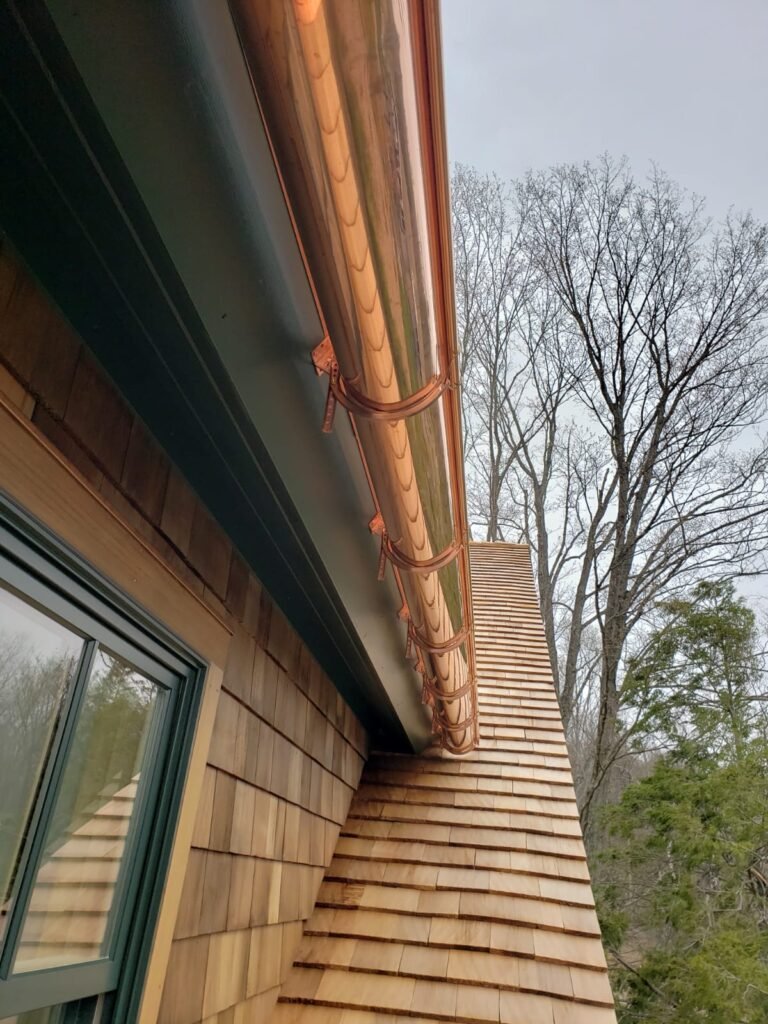
Avoiding Problem Areas: We avoid downspout placement near basement windows, utility connections, or other vulnerable areas where water concentration could create problems. Strategic placement prevents issues while ensuring effective drainage.
Architectural Integration: Downspout placement should complement your home’s appearance. We position downspouts where they’re least visually intrusive while maintaining function. Color matching and careful routing minimize aesthetic impact.
Expansion Considerations: Future landscaping plans, patio additions, or property modifications may affect optimal downspout placement. We discuss long-term plans ensuring downspout locations remain functional as your property evolves.
Existing System Evaluation: When adding downspouts to existing systems, we evaluate current placement adequacy. Sometimes adding one or two downspouts solves persistent drainage problems without complete system replacement.
Pitch and Roof Design Factors: Roof pitch affects water velocity and volume reaching gutters. Steep roofs concentrate water, potentially requiring additional downspouts. Complex roof designs with valleys and multiple planes need careful analysis ensuring adequate drainage.
Connecticut Climate Adaptation: Ice and snow loading, spring runoff volumes, and severe storm intensity influence optimal downspout quantity and placement. We design systems accounting for Connecticut-specific weather patterns.
Proper placement and sizing ensure your downspout system handles Connecticut’s water volumes effectively, protecting your foundation and property comprehensively.
Extension Types and Options
Choosing the Right Water Disposal Solution
Various extension options suit different properties, budgets, and drainage needs. Understanding choices helps homeowners select appropriate solutions.
Flexible Corrugated Extensions: These economical extensions attach to downspouts and roll out directing water away from foundations. Easy installation and adjustment suit various situations. However, they can be unsightly, shift position, create trip hazards, and may not provide permanent solutions for serious drainage problems.
Rigid Plastic Extensions: Solid plastic extensions provide more permanent solutions than flexible types. They maintain position better and offer cleaner appearance. Available in various lengths and colors, they suit properties where above-ground extensions work appropriately.
Hinged Flip-Up Extensions: These extensions lie flat when not needed, flipping down during rain. Hinged designs eliminate trip hazards and mowing obstacles. They suit areas where permanent extensions interfere with property use but adequate water disposal requires distance from foundations.
Pop-Up Emitters: Underground drain pipes carry water from downspouts to pop-up emitters that open during water flow, disposing water at safe locations. When not flowing, pop-ups close flush with ground level. This underground approach provides excellent drainage without visible extensions.
Various extension options suit different properties, budgets, and drainage needs. Understanding choices helps homeowners select appropriate solutions.
Flexible Corrugated Extensions: These economical extensions attach to downspouts and roll out directing water away from foundations. Easy installation and adjustment suit various situations. However, they can be unsightly, shift position, create trip hazards, and may not provide permanent solutions for serious drainage problems.
Rigid Plastic Extensions: Solid plastic extensions provide more permanent solutions than flexible types. They maintain position better and offer cleaner appearance. Available in various lengths and colors, they suit properties where above-ground extensions work appropriately.
Hinged Flip-Up Extensions: These extensions lie flat when not needed, flipping down during rain. Hinged designs eliminate trip hazards and mowing obstacles. They suit areas where permanent extensions interfere with property use but adequate water disposal requires distance from foundations.
Pop-Up Emitters: Underground drain pipes carry water from downspouts to pop-up emitters that open during water flow, disposing water at safe locations. When not flowing, pop-ups close flush with ground level. This underground approach provides excellent drainage without visible extensions.
Underground Drainage Systems: Buried pipes permanently carry downspout water to appropriate disposal areas. Underground systems eliminate surface extension visibility, trip hazards, and mowing obstacles while providing reliable year-round drainage. They suit properties prioritizing aesthetics or requiring significant disposal distances.
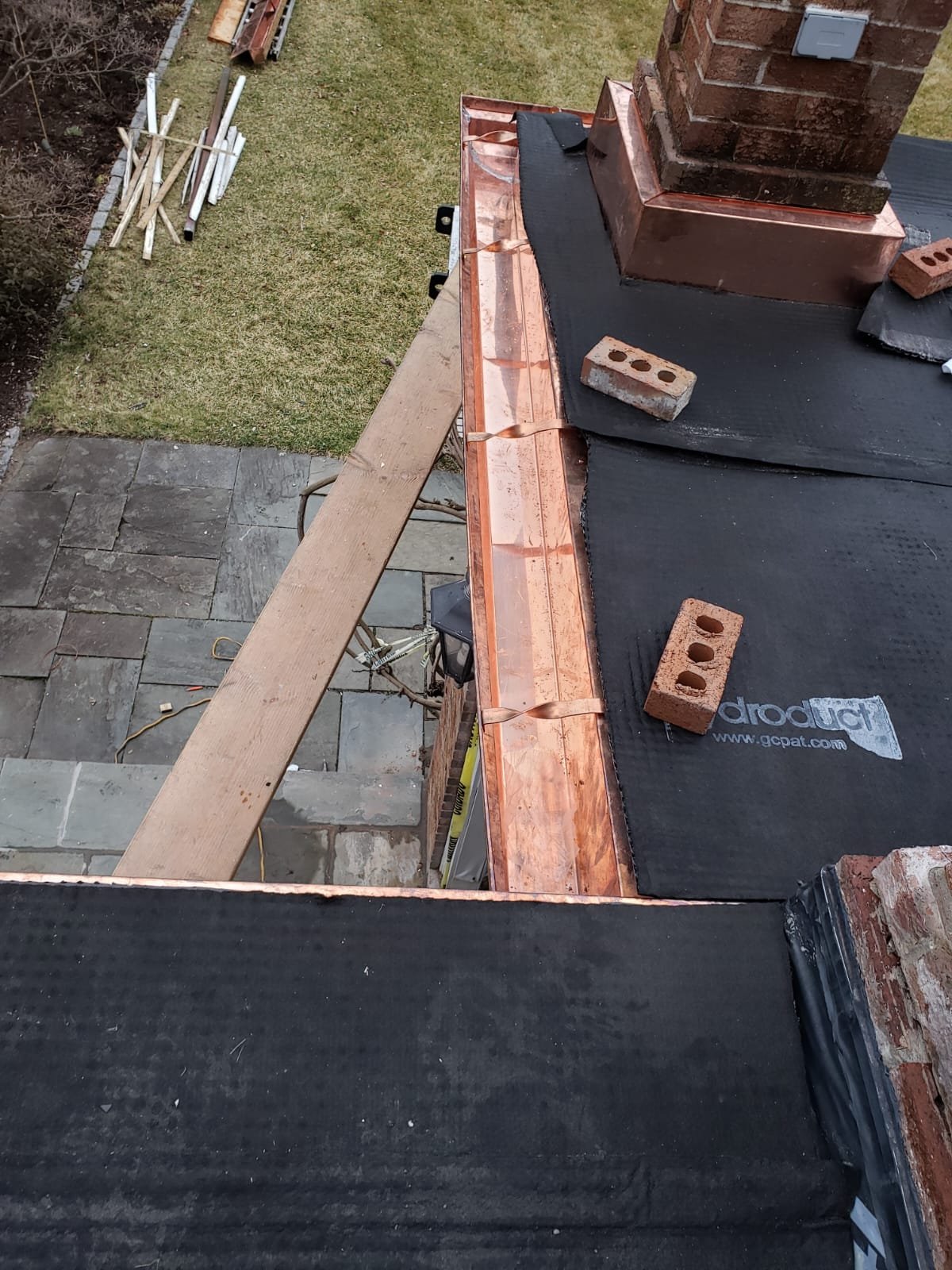
Splash Blocks: Concrete or plastic splash blocks placed under downspouts disperse water over wider areas, reducing erosion and directing flow away from foundations. Splash blocks suit situations where water disposal doesn’t require significant distance but concentrated flow causes problems.
Rain Barrels and Collection Systems: Environmentally conscious homeowners may use rain barrels collecting downspout water for irrigation. Overflow capabilities ensure excess water during heavy storms drains appropriately. Collection systems reduce water bills while managing roof runoff.
French Drain Integration: Properties with serious drainage challenges may benefit from French drains receiving downspout water. Perforated pipes in gravel-filled trenches carry water underground to appropriate disposal areas. We can integrate downspouts with French drain systems providing comprehensive drainage.
Dry Well Systems: Dry wells receive downspout water underground, allowing gradual soil absorption. Gravel-filled pits with perforated catch basins provide drainage without surface water flow. Dry wells suit properties where above-ground water disposal creates problems.
Combination Approaches: Many properties benefit from combining extension types. Underground systems for front downspouts maintain curb appeal, while less visible rear downspouts use above-ground extensions. We design combination solutions optimizing both function and aesthetics.
Material Durability: Extension material affects longevity. Quality UV-resistant plastics last years in Connecticut’s sun. Corrugated flexible extensions may require periodic replacement. Underground components using proper materials perform for decades.
Freeze Protection: Connecticut winters demand extensions that withstand freezing without cracking. We specify materials proven to handle freeze-thaw cycles reliably.
Our experience with every extension type allows us to recommend solutions providing optimal drainage for your specific property, budget, and preferences.
quality Services
We Provide Quality
Roofing Services Throughout CT
5 Star Reviews
Projects
Teams available
Free Estimate – Contact Us Today
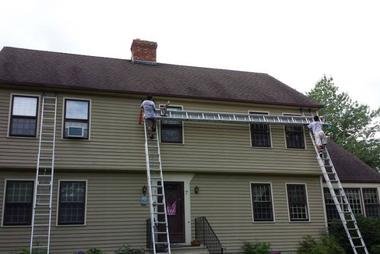
Underground Drainage Solutions
Permanent Water Management Systems
Underground drainage provides superior long-term performance while eliminating visible extensions. Understanding these systems helps homeowners evaluate this investment.
System Components: Underground drainage includes buried pipes connecting downspouts to disposal points, catch basins at downspout locations, and emitters or outlets at termination points. Quality components ensure reliable long-term performance.
Installation Process: Installation involves trenching from downspouts to disposal areas, installing proper bedding materials, placing pipes with correct slope, connecting to downspouts, and installing emitters or termination points. Professional installation ensures proper function and longevity.
Pipe Materials: PVC and corrugated plastic pipes both suit underground drainage. PVC provides maximum durability and smooth interiors promoting flow. Corrugated pipes offer flexibility for curved routes. We select materials appropriate for each application.
Slope Requirements: Underground pipes require proper slope ensuring water flows to disposal points. Minimum 1-2% grade prevents standing water and sediment accumulation. We calculate and implement correct slopes during installation.
Disposal Point Selection: Water must discharge at appropriate locations where natural drainage carries it away without creating problems. We evaluate terrain, soil conditions, and property characteristics identifying optimal disposal points.
Maintenance Access: Quality underground systems include cleanout points allowing maintenance access if needed. Strategic cleanout placement facilitates periodic inspection and clearing if sediment accumulates.
Freeze Protection Depth: Connecticut frost depths require proper burial depth preventing freeze damage. We install pipes below frost lines or use insulation in shallow sections ensuring winter reliability.
Pop-Up Emitter Advantages: Pop-up emitters at termination points open during water flow, then close flush with ground level. This design prevents debris entry and pest access while allowing mowing without obstruction.
Capacity Planning: Underground systems must handle peak water volumes during Connecticut’s heaviest storms. We size pipes appropriately ensuring adequate capacity without overflow during extreme rainfall.
Integration with Property Drainage: Underground downspout drainage should coordinate with overall property drainage patterns. We ensure systems complement natural drainage, existing French drains, or other water management features.
Aesthetic Benefits: Underground systems eliminate visible extensions, maintaining landscape appearance and property aesthetics. Front yard applications particularly benefit from underground approach enhancing curb appeal.
Long-Term Performance: Properly installed underground drainage performs for decades with minimal maintenance. Initial investment returns value through reliable performance and preserved property appearance.
Foundation Protection: Underground systems provide superior foundation protection by carrying water far from structures through reliable year-round operation unaffected by shifting, disconnection, or damage affecting surface extensions.
For properties where drainage is critical or aesthetics are important, underground systems provide excellent solutions worth the additional investment.
Common Downspout Problems
Identifying and Addressing Drainage Issues
Recognizing downspout problems helps homeowners seek solutions before damage occurs. Understanding common issues promotes proactive maintenance.
Insufficient Extension Distance: The most common problem is extensions not reaching far enough from foundations. Water depositing within 5-10 feet of foundations can still cause problems. We ensure extensions carry water to safe disposal distances.
Disconnected or Shifted Extensions: Flexible extensions shift from mowing, weather, or foot traffic. Disconnected extensions defeat drainage systems completely. Regular inspection and properly secured extensions prevent these problems.
Clogged Downspouts: Debris blocking downspouts prevents drainage causing gutter overflow. Leaves, shingle granules, and organic material accumulate creating blockages. Regular cleaning and gutter guards reduce clogging frequency.
Inadequate Downspout Quantity: Too few downspouts for roof area causes overflow regardless of gutter condition. Adding downspouts solves persistent overflow problems when gutter capacity is adequate but water volume exceeds downspout drainage.
Improper Downspout Sizing: Undersized downspouts create bottlenecks limiting drainage. Upgrading to appropriate sizing ensures water flows freely from gutters preventing overflow.
Missing or Damaged Components: Lost elbow pieces, damaged connections, or deteriorated downspouts prevent proper function. Replacing damaged components restores system effectiveness.
Ice Blockage: Connecticut winters can create ice blockages in downspouts preventing drainage. Proper system design, heating cables in problem areas, or underground drainage below frost lines prevent ice-related problems.
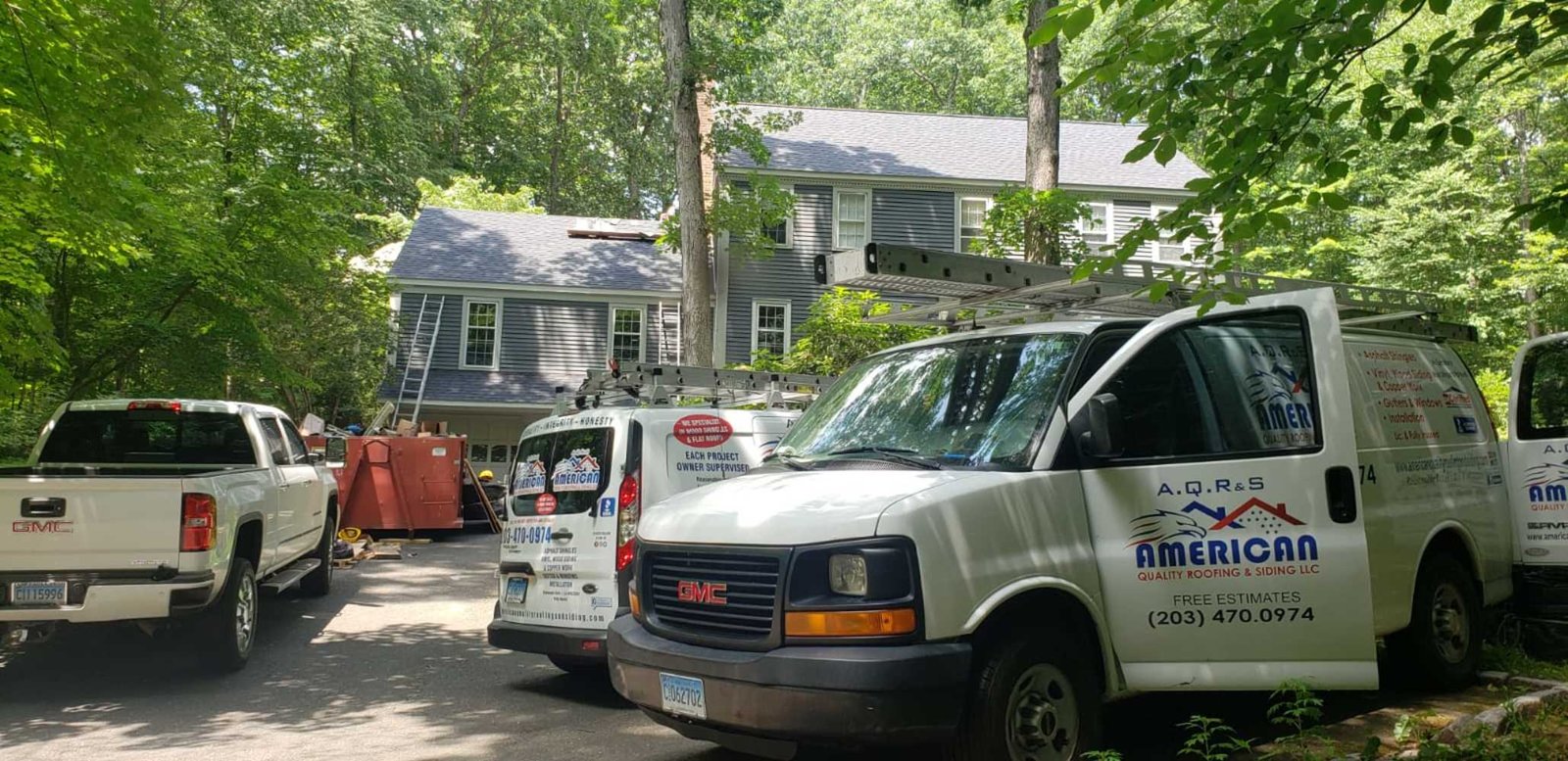
Foundation Disposal: Downspouts depositing directly at foundation walls defeat gutter systems completely. This common problem causes the exact water damage gutters aim to prevent. Proper extensions are essential.
Erosion at Disposal Points: Even with extensions, concentrated water flow can erode soil at disposal points. Splash blocks, rock beds, or underground drainage at termination points prevent erosion while maintaining drainage.
Drainage Path Problems: Extensions directing water toward neighboring properties, into drainage swales, or other inappropriate areas create problems. Strategic disposal location selection ensures water drains appropriately.
Seasonal Maintenance Neglect: Extensions removed for winter, mowing, or other reasons and not reinstalled leave systems incomplete. Year-round extension use is essential for continuous protection.
Underground System Failures: Buried drainage can fail from crushing, root intrusion, or sediment accumulation. Proper installation depth, quality materials, and periodic maintenance ensure underground system reliability.
Splash-Back Issues: Downspouts too close to siding can cause splash-back saturating exterior walls. Proper extension or elbow installation directs water away preventing wall moisture.
Identifying these problems allows targeted solutions restoring effective drainage and foundation protection.
Downspout Maintenance Requirements
Protecting Your Drainage Investment
Regular maintenance ensures downspout systems function effectively. Understanding care requirements helps homeowners maintain proper drainage.
Seasonal Inspection: Check downspouts and extensions seasonally, particularly spring and fall. Look for damage, disconnections, clogs, or position changes. Early detection allows simple corrections preventing problems.
Extension Position Verification: Ensure extensions remain properly positioned directing water away from foundations. Replace or reposition shifted extensions immediately. Verify adequate distance from foundation walls.
Clog Clearing: Flush downspouts periodically removing debris. Running water from hoses down downspouts clears minor accumulations. Persistent clogs may require professional cleaning or disassembly.
Connection Security: Check all connections between gutters, downspouts, elbows, and extensions. Tighten loose connections and replace damaged components. Secure connections prevent leaks and disconnections.
Underground System Maintenance: For underground drainage, verify pop-up emitters open and close properly. Check cleanout access points. Consider professional inspection every few years ensuring system remains clear.
Winter Preparation: Before winter, ensure downspouts are clear and extensions are secure. Ice accumulation can damage loose components. Well-maintained systems handle winter conditions better.
Damage Assessment: After severe storms, inspect for damage from falling branches, wind, or ice. Address damage promptly preventing progressive deterioration and maintaining effective drainage.
Erosion Monitoring: Check disposal areas for erosion. If concentrated water flow causes problems, add splash blocks, rock beds, or consider underground extensions to termination points preventing erosion.
Gutter Guard Coordination: If using gutter guards, ensure they don’t interfere with downspout entry. Some designs can cause debris accumulation at downspout openings. Verify clear flow paths.
Freeze-Thaw Attention: Connecticut’s freeze-thaw cycles can shift extensions or damage connections. Spring inspection should specifically check for winter damage requiring attention.
Component Replacement: Replace deteriorated extensions, damaged elbows, or worn components promptly. Delaying replacement allows damage to worsen and may compromise drainage effectiveness.
Professional Service: Consider professional downspout inspection and maintenance as part of regular gutter service. Professionals identify subtle problems and ensure complete system effectiveness.
Regular maintenance extends system life, ensures continuous protection, and prevents small problems from becoming major drainage failures.
Drainage Solutions for Challenging Properties
Custom Solutions for Difficult Situations
Some properties face unique drainage challenges requiring specialized approaches. Understanding available solutions helps homeowners address difficult situations.
Steep Slope Properties
Poor Soil Drainage
Limited Property Size
Multiple Building Proximity
Hardscape Complications
Wetland or Water Table Issues
Neighboring Property Concerns
Historic Property Restrictions
Septic System Coordination
Don’t Delay Professional Repair
Our Downspout Installation Process
Professional Drainage System Installation
Our systematic approach ensures effective water management tailored to your property’s specific needs.
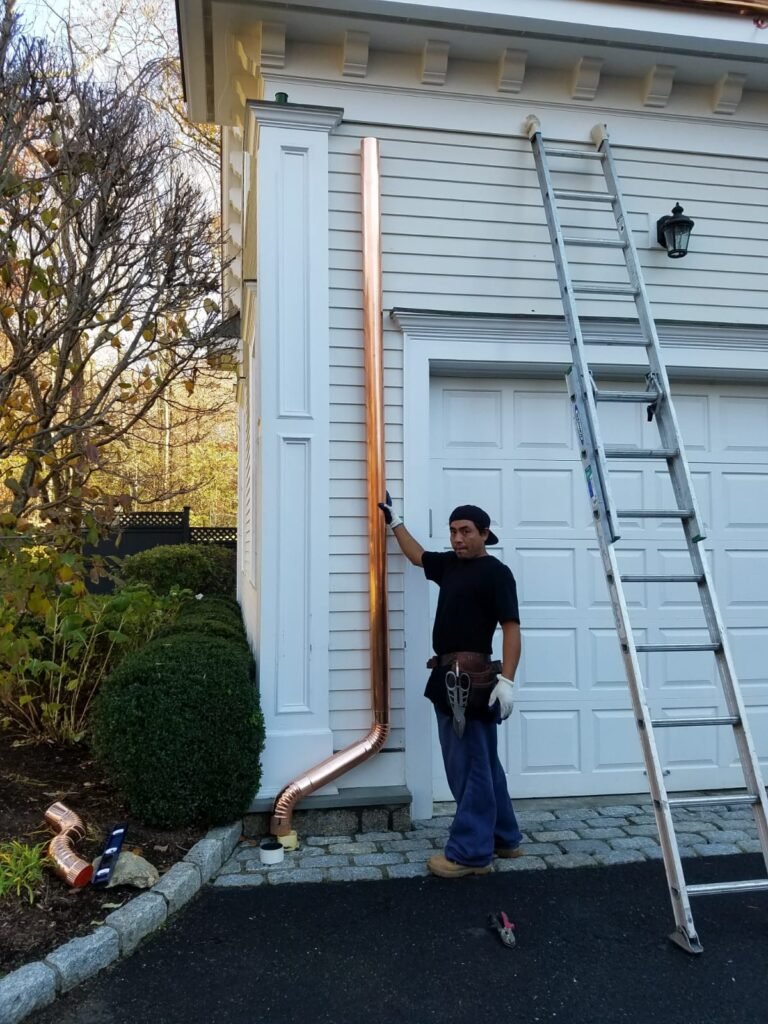
Comprehensive Drainage Assessment
We evaluate your property’s topography, soil conditions, existing drainage patterns, and problem areas. This assessment identifies optimal downspout placement and extension approaches providing complete protection.
Custom System Design
Based on assessment findings, we design downspout systems specific to your property. Design includes placement recommendations, sizing specifications, extension types, and disposal locations ensuring effective drainage.
Material Selection and Planning
We discuss options for downspouts, extensions, and drainage solutions helping you select approaches appropriate for your needs and budget. We explain advantages and considerations for each option.
Professional Installation
Our experienced crews install downspouts with proper connections, secure attachments, and correct positioning. Extensions receive careful placement ensuring adequate distance and proper routing.
Underground Component Installation (if applicable)
For underground systems, we excavate trenches, install proper bedding, place pipes with correct slope, and install pop-up emitters or termination points. Professional installation ensures long-term performance.
Testing and Adjustment
We test water flow, verify proper drainage, check all connections, and ensure extensions maintain position. Any necessary adjustments are made before considering work complete.
Maintenance Guidance and Documentation
We review your system’s operation, provide maintenance recommendations, and answer all questions. You’ll understand how your drainage system works and what care maintains effectiveness.
Why Choose Us for Downspout Solutions
Connecticut’s Drainage Specialists
25 Years of Drainage Experience Since 1999, we’ve designed and installed downspout systems protecting Connecticut foundations. This experience ensures we understand property-specific challenges and provide effective solutions.
Comprehensive Property Assessment We evaluate your complete property, not just downspout locations. This thorough approach ensures drainage solutions address your specific situation comprehensively.
Custom Solution Design We don’t apply one-size-fits-all approaches. Every property receives custom design addressing its unique drainage challenges, soil conditions, and topography.
Quality Materials and Installation We use durable materials proven to withstand Connecticut’s climate and install systems following best practices ensuring long-term reliability.
Underground Drainage Expertise Our crews have extensive experience with underground systems requiring trenching, proper slope calculation, and professional installation. We deliver underground drainage that performs for decades.
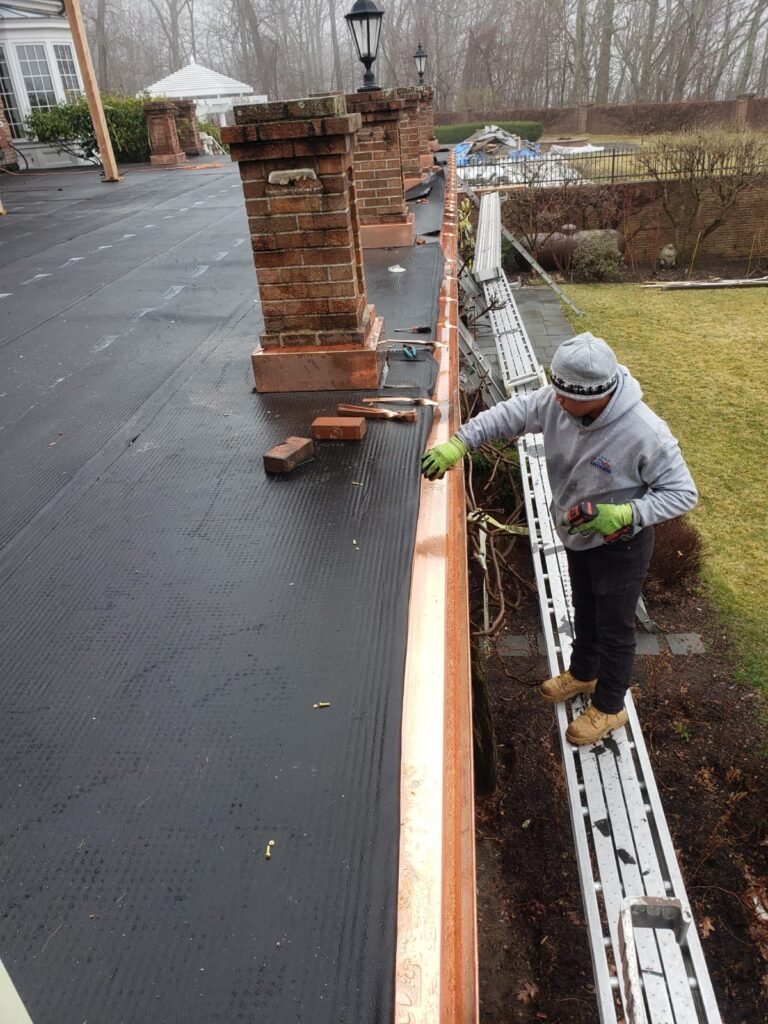
Problem-Solving Experience Challenging properties throughout Connecticut have taught us creative solutions for virtually any drainage situation. We can solve problems others might find insurmountable.
Licensed and Insured Protection Connecticut License #HIC 0633301 and comprehensive insurance protect you throughout every project providing security and accountability.
Transparent Pricing We provide detailed estimates clearly explaining all costs. Our transparent approach allows confident decision-making based on complete cost understanding.
Complete Service Integration As a full-service roofing and exterior company, we coordinate downspout work with gutters, roofing, and siding ensuring comprehensive water management.
FAQs
Common Questions About Downspouts and Extensions
Downspout and drainage projects raise important questions about placement, extensions, and water management. Over our 25 years serving Connecticut families, we’ve helped hundreds of homeowners protect their foundations with effective drainage systems. Below are the most common concerns homeowners have about downspouts and extensions. If you don’t see your specific question answered here, our team is always available to provide personalized guidance for your situation.
Protect Your Foundation with Professional Downspout Solutions
Don’t let inadequate downspouts threaten your foundation, basement, and property. Proper water disposal is essential for protecting your home’s structural integrity and value.
Our drainage specialists provide comprehensive assessment, custom system design, quality installation, and reliable solutions. With over 25 years of experience and 778+ successfully completed projects, we have the expertise to solve your drainage challenges.
From simple extension installation to complex underground systems, we deliver water management protecting your home effectively. Our A+ Better Business Bureau rating, licensing, and insurance provide the accountability you deserve.
- Licensed and Insured – CT #HIC 0633301
- Factory Certified by GAF Materials Corporation
- ShingleMaster™ CertainTeed Select Contractors
- A+ Better Business Bureau Rating


